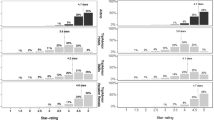Abstract
The existing collaborative recommendation algorithms have poor robustness against shilling attacks. To address this problem, in this paper we propose a robust recommendation method based on suspicious users measurement and multidimensional trust. Firstly, we establish the relevance vector machine classifier according to the user profile features to identify and measure the suspicious users in the user rating database. Secondly, we mine the implicit trust relation among users based on the user-item rating data, and construct a reliable multidimensional trust model by integrating the user suspicion information. Finally, we combine the reliable multidimensional trust model, the neighbor model and matrix factorization model to devise a robust recommendation algorithm. The experimental results on the MovieLens dataset show that the proposed method outperforms the existing methods in terms of both recommendation accuracy and robustness.






Similar content being viewed by others
References
Aghili, G., Shajari, M., Khadivi, S., & Morid, M.A. (2011). Using genre interest of users to detect profile injection attacks in movie recommender systems. In Proceedings of the 10th international conference on Machine Learning and Applications and Workshops (pp. 49–52).
Burke, R., Mobasher, B., Williams, C., & Bhaumik, R. (2006). Classification features for attack detection in collaborative recommender systems. In Proceedings of the 12th ACM SIGKDD international conference on Knowledge discovery and data mining (pp. 542–547).
Cheng, Z., & Hurley, N. (2010). Robust collaborative recommendation by least trimmed squares matrix factorization. In Proceedings of the 22nd IEEE international conference on tools with artificial intelligence (pp. 105–112).
Dyer, R.F. (1992). Group decision support with the analytic hierarchy process. Decision Support Systems, 8(2), 99–124.
Gunes, I., Kaleli, C., Bilge, A., & Polat, H. (2014). Shilling attacks against recommender systems: a comprehensive survey. Artificial Intelligence Review, 42(4), 767–799.
Hurley, N.J., O’Mahony, M.P., & Silvestre, G.C. (2007). Attacking recommender systems: A cost-benefit analysis. IEEE Intelligent Systems, 22(3), 64–68.
Kantor, P.B., Rokach, L., Ricci, F., & Shapira, B. (2011). Recommender systems handbook: Springer.
Kwon, K., Cho, J., & Park, Y (2009). Multidimensional credibility model for neighbor selection in collaborative recommendation. Expert Systems with Applications, 36(3), 7114–7122.
Mackay, D. (1992). The evidence framework applied to classification networks. Neural computation, 4(5), 720–736.
Maida, M., Maier, K., Obwegeser, N., & Stix, V. (2012). A multidimensional model of trust in recommender systems. In Proceedings of 13th International Conference on Electronic Commerce and Web Technologies (pp. 212–219).
Mehta, B., Hofmann, T., & Nejdl, W. (2007). Robust collaborative filtering. In Proceedings of the 2007 ACM conference on Recommender systems (pp. 49–56).
Miller, B.N., Albert, I., Lam, S. K., Konstan, J. A., & Riedl, J. (2003). MovieLens unplugged: experiences with an occasionally connected recommender system. In Proceedings of the 8th international conference on Intelligent user interfaces (pp. 263–266).
Mobasher, B., Burke, R., & Sandvig, J.J. (2006). Model-based collaborative filtering as a defense against profile injection attacks. In Proceedings of the 21st national conference on artificial intelligence (pp. 1388–1393).
O’Donovan, J., & Smyth, B. (2005). Trust in recommender systems. In Proceedings of the 10th international conference on Intelligent user interfaces (pp. 167–174).
O’Mahony, M., Hurley, N., Kushmerick, N., & Silvestre, G. (2004a). Collaborative recommendation: A robustness analysis. ACM Transactions on Internet Technology (TOIT), 4(4), 344–377.
O’Mahony, M.P., Hurley, N.J., & Silvestre, G.C. (2004b). Efficient and secure collaborative filtering through intelligent neighbour selection. In Proceedings of the 16th European conference on artificial intelligence (pp. 383–387).
O’Mahony, M.P. (2004). Towards robust and efficient automated collaborative filtering. PhD dissertation: University College Dublin.
Pitsilis, G., & Marshall, L.F. (2004). A model of trust derivation from evidence for use in recommendation systems. Computing Science: University of Newcastle upon Tyne.
Sandvig, J.J., Mobasher, B., & Burke, R. (2007). Robustness of collaborative recommendation based on association rule mining. In Proceedings of the 2007 ACM conference on Recommender systems (pp. 105–112).
Tipping, M. (2001a). The relevance vector machine. Advances in Neural Information Processing Systems, 12, 652–658.
Tipping, M.E. (2001b). Sparse Bayesian learning and the relevance vector machine. The journal of machine learning research, 1, 211–244.
Weng, J., Miao, C., & Goh, A. (2006). Improving collaborative filtering with trust-based metrics. In Proceedings of the 2006 ACM symposium on Applied computing (pp. 1860–1864).
Williams, C.A., Mobasher, B., & Burke, R. (2007a). Defending recommender systems: detection of profile injection attacks. Service Oriented Computing and Applications, 1(3), 157–170.
Williams, C.A., Mobasher, B., Burke, R., & Bhaumik, R. (2007b). Detecting profile injection attacks in collaborative filtering: a classification-based approach. In Proceedings of the 8th Knowledge Discovery on the Web International Conference on Advances in Web Mining and Web Usage Analysis (pp. 167–186).
Xu, H., Wu, X., & Li, X. (2009). Comparision study of Internet recommendation system. Journal of Software, 20(2), 350–362.
Zhang, S., Ouyang, Y., Ford, J., & Makedon, F. (2006). Analysis of a low-dimensional linear model under recommendation attacks. In Proceedings of the 29th annual international ACM SIGIR conference on Research and development in information retrieval (pp. 517–524).
Author information
Authors and Affiliations
Corresponding author
Additional information
This work was supported by the National Natural Science Foundation of China (No.61379116), the Natural Science Foundation of Hebei Province, China (No. F2013203124, No. F2015203046) , the Key Program of Research on Science and Technology of Higher Education Institutions of Hebei Province, China (No. ZH2012028) and the Scientific Research Foundation of Liaoning Provincial Education Department, China (No. L2015240).
Rights and permissions
About this article
Cite this article
Yi, H., Zhang, F. Robust recommendation method based on suspicious users measurement and multidimensional trust. J Intell Inf Syst 46, 349–367 (2016). https://doi.org/10.1007/s10844-015-0375-2
Received:
Revised:
Accepted:
Published:
Issue Date:
DOI: https://doi.org/10.1007/s10844-015-0375-2




